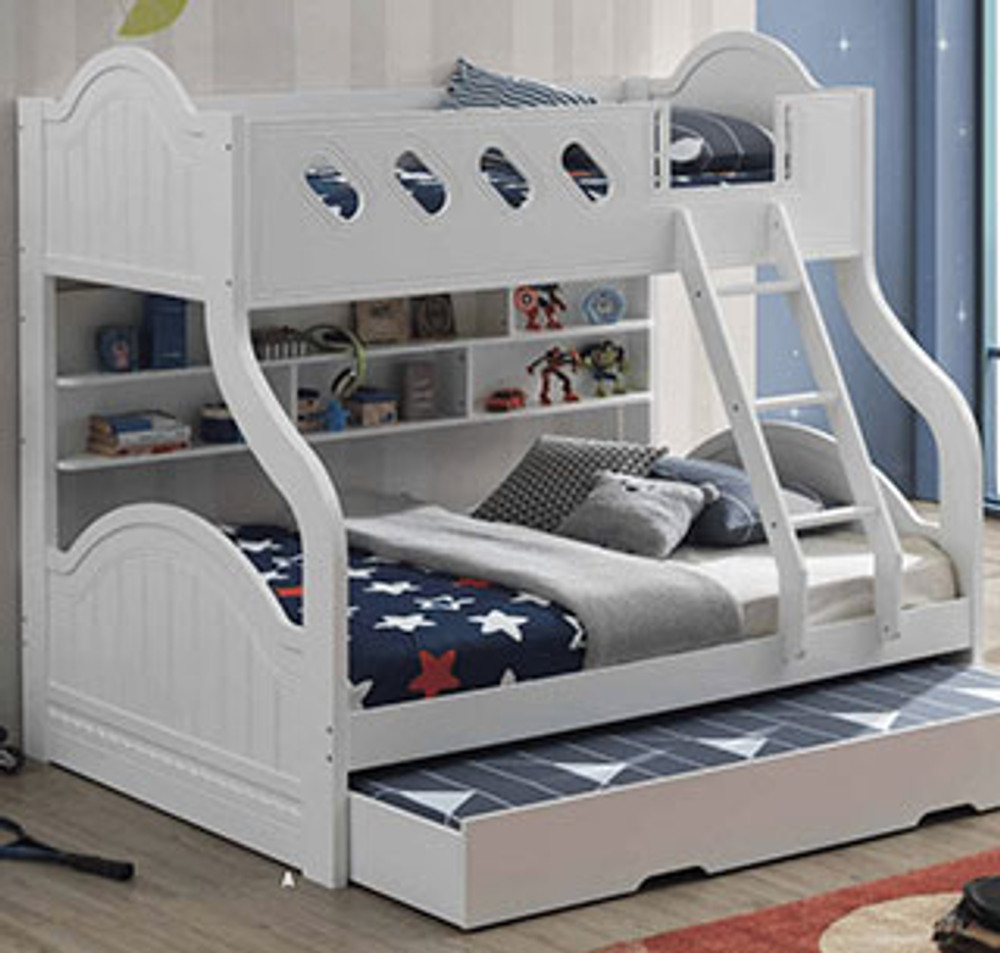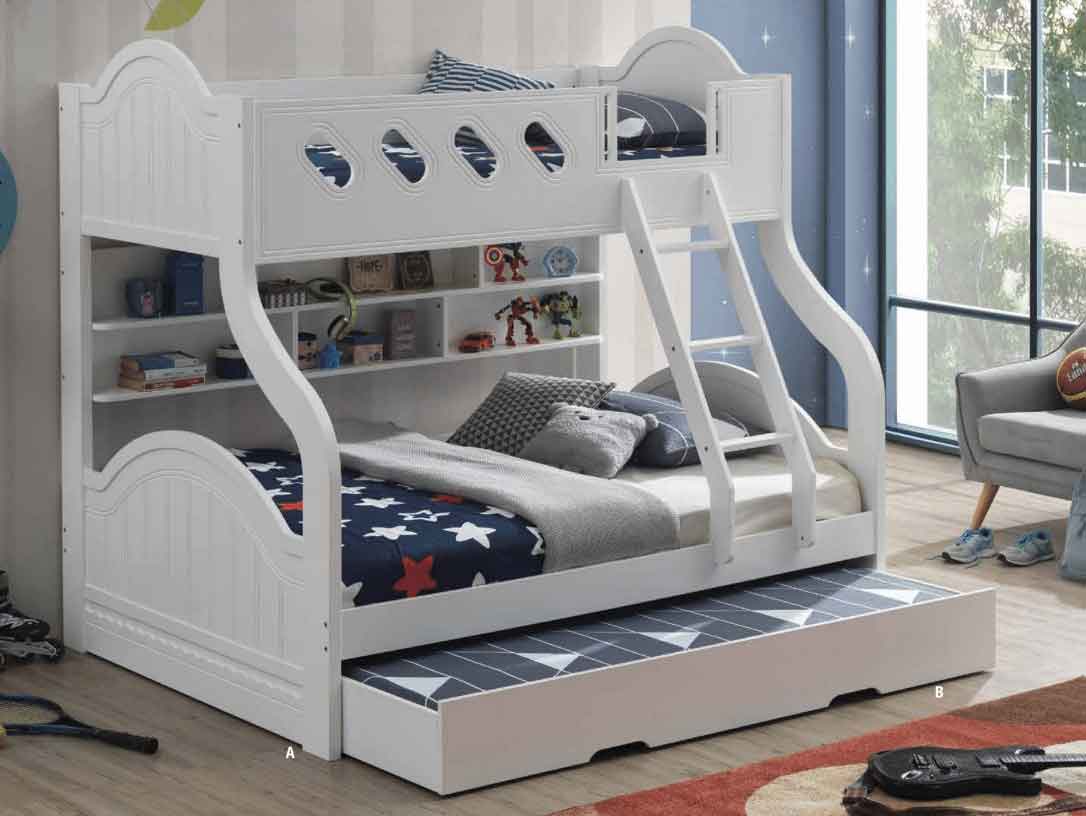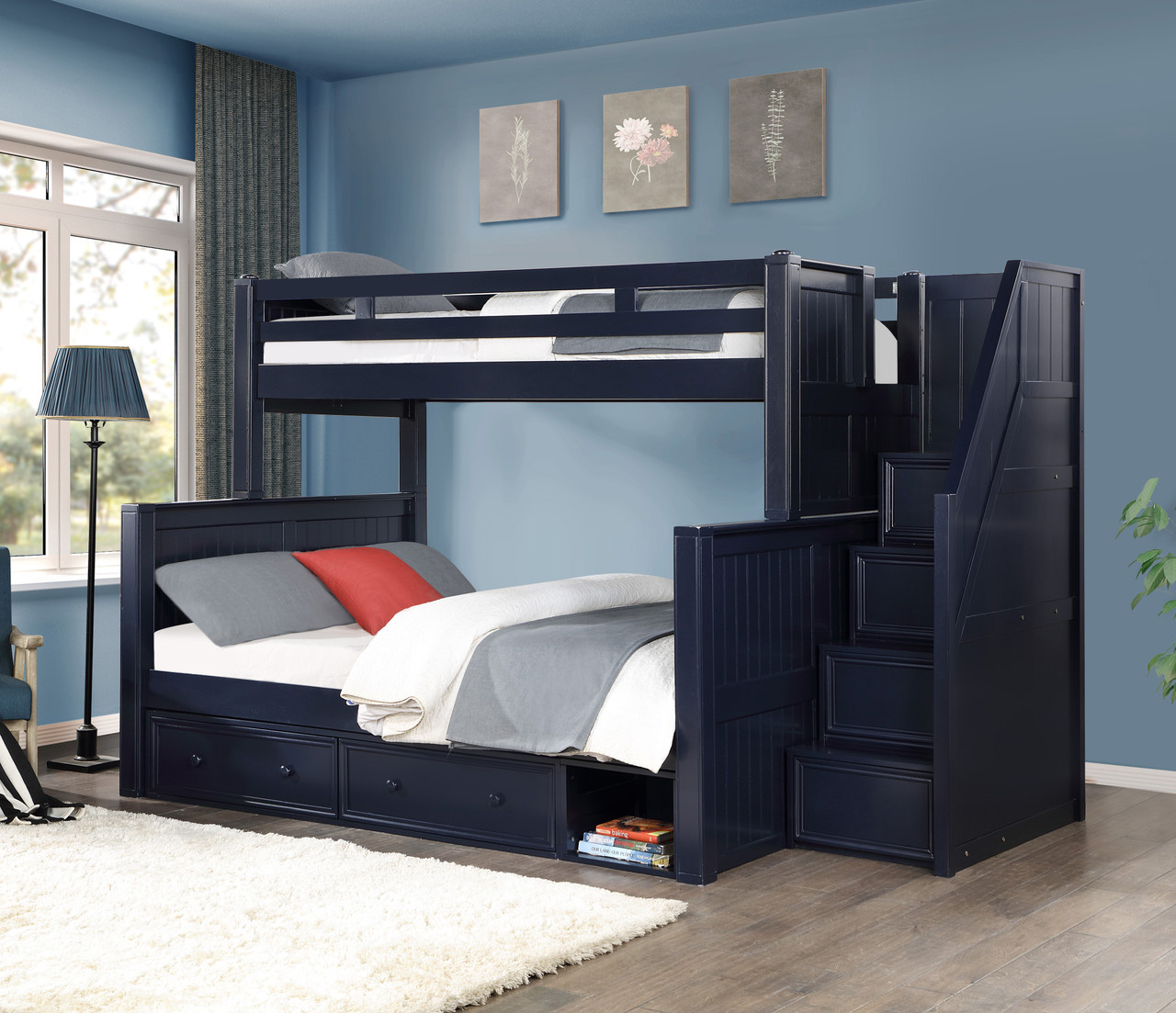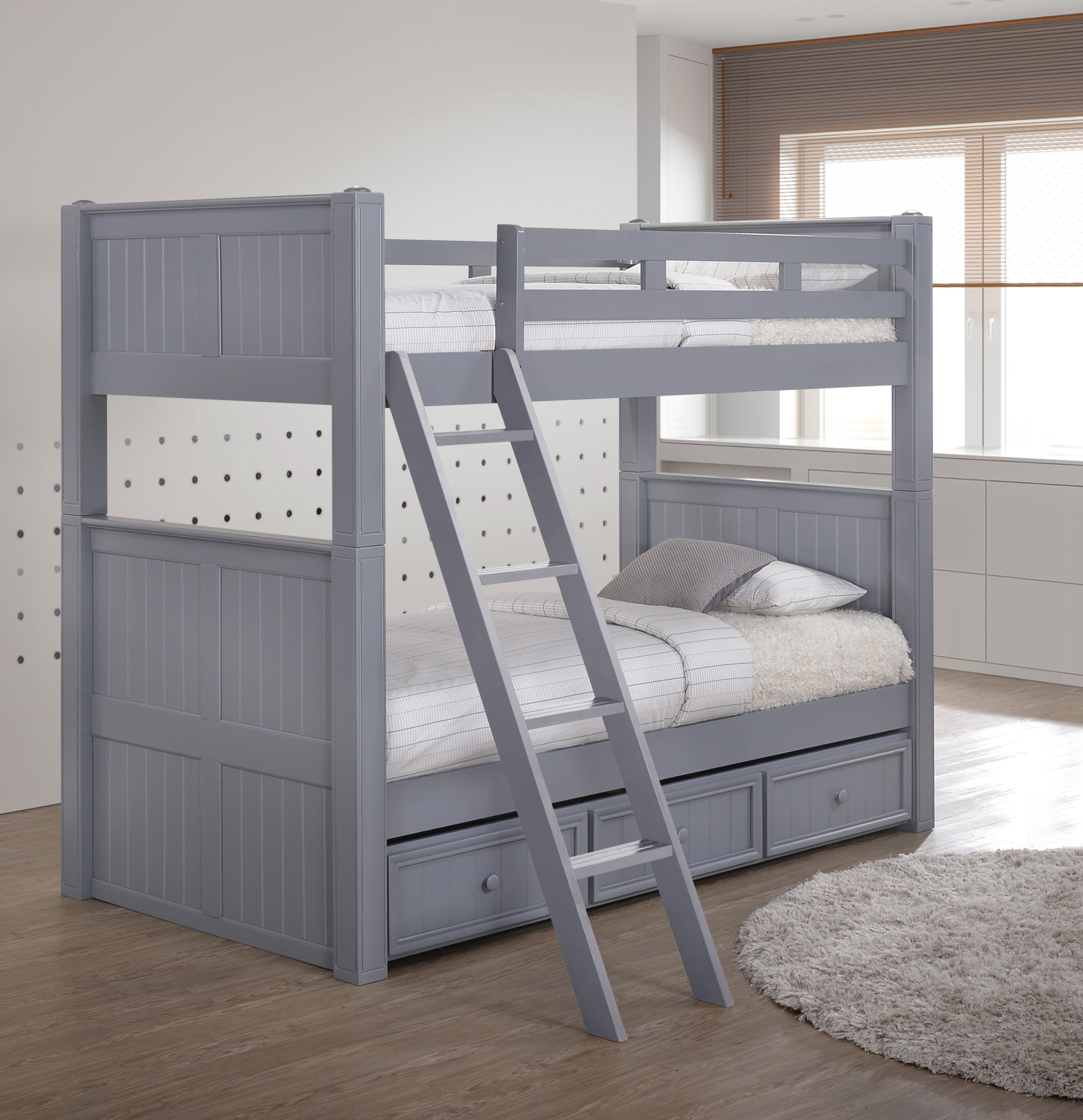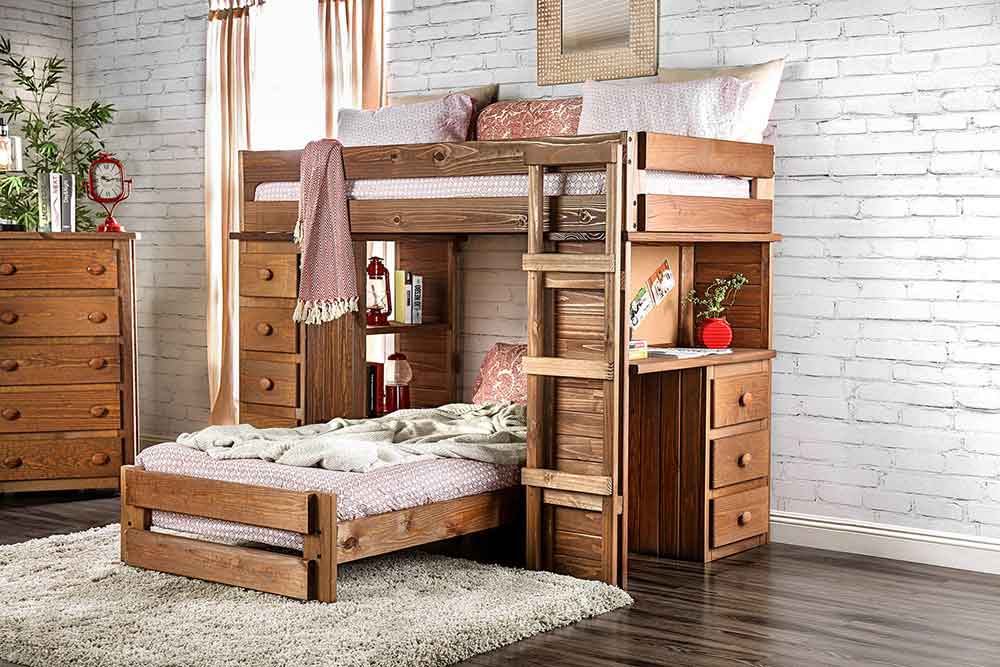What Age is Appropriate for Bunk Beds? - JustBunkBeds
Posted by UPW on Jan 10th 2025
Bunk beds are a practical and versatile solution for maximizing sleeping space in shared bedrooms, but age-appropriate use is critical to ensure safety and comfort. Different age groups have specific needs and safety concerns that must be addressed when deciding whether a bunk bed is suitable. From young children to teenagers, understanding these considerations can help parents and caregivers make informed decisions.
Can Young Children (1–4 Years Old) Sleep in a Bunk Bed Safely?
According to recommendations from the Consumer Product Safety Commission (CPSC), the safest age for children to use the top bunk of a bunk bed is six years or older. By this age, children typically have the coordination and spatial awareness needed to climb ladders safely and sleep securely in an elevated space.
Guardrails
Guardrails are crucial for the top bunk, extending at least five inches above the mattress surface to prevent accidental falls. To ensure additional safety, the gaps in the guardrails must be narrow enough to prevent entrapment, especially for children who may shift during sleep. These safety standards are non-negotiable for parents seeking secure elevated beds for their kids.
Steps vs. Ladders
Choosing between steps and ladders largely depends on the age and abilities of the child. Steps are often considered safer for younger children due to their wider, stable surfaces and gradual incline, providing a natural climbing experience. Additionally, steps can double as built-in storage compartments, optimizing functionality.
On the other hand, ladders are a space-saving option, with straight or angled designs to suit different room layouts. Angled ladders offer a slightly easier climb for younger users, while straight ladders take up less floor space, making them ideal for compact rooms. The right choice ultimately depends on the child’s comfort and the room’s needs.
Lower Bunk Safety
The lower bunk is located close to the ground, making it an ideal option for younger children under six. This proximity to the floor minimizes the risk of injury from falls, which is a key concern for younger children who may lack the awareness and coordination needed to safely navigate a higher sleeping area.
Additionally, the lower bunk often features a more stable sleeping setup, as it doesn't require the same height clearance needed for the upper bunk. Beds like the Juno Twin Full Bunk Bed with Steps in White incorporate under-bed storage drawers that rest directly on the floor, providing a practical solution for families needing to maximize space. This design is particularly beneficial in shared or smaller rooms, where safety and functionality are both top priorities.
Proper supervision and regular maintenance, such as checking for loose screws or worn hardware, can further enhance safety. Adhering to these safety measures guarantees peace of mind while optimizing shared bedroom spaces for growing families.
Optimal Bunk Bed Configurations for Ages 5 to 12
Children aged 5 to 12 require bunk bed configurations that cater to their unique developmental needs, ensuring both safety and usability as they grow. The right configuration should not only provide a secure sleeping arrangement but also adapt to their evolving activities, such as studying, playing, or accommodating friends for sleepovers.
Twin-over-Twin Bunk Beds
Twin-over-twin bunk beds are perfectly suited for younger children or siblings sharing a room. Their compact dimensions are ideal for smaller spaces, offering two separate sleeping surfaces while leaving ample room for play or other furniture. Additionally, the lower bunk’s proximity to the ground makes it safer for younger users, while the top bunk is accessible for older kids.
You can transform the lower bunk into a versatile area for relaxation, with soft cushions and reading lights creating a cozy nook for downtime. As your children grow, the twin-over-twin setup remains practical, offering individual sleeping arrangements in a manageable footprint.
Twin-over-Full Bunk Beds
For families with children of varying ages, twin-over-full bunk beds provide a thoughtful solution. The top twin bunk is ideal for younger children, while the full-size bottom bunk accommodates older siblings or even adults during sleepovers. This added versatility ensures that the bed grows with the family’s changing needs.
The larger bottom bunk can double as a casual seating area, offering enough space for children to spread out with books, crafts, or quiet play. This makes twin-over-full configurations especially suitable for active kids who enjoy multifunctional spaces. Their adaptability and size flexibility make them a smart choice for shared bedrooms or growing households.
Loft Beds with Desks
Loft beds with desks are an excellent choice for children aged 8 and above who require a balance between study and sleep. This design promotes independence, giving children a quiet zone for homework or creative projects without encroaching on the rest of the room.
Shelving and built-in drawers often accompany the desk area, providing convenient storage for books, school supplies, or personal items. Loft beds encourage organization while fostering a sense of responsibility in maintaining a tidy and functional workspace, making them particularly beneficial for school-aged children with growing academic demands.
Bunk Beds with Trundles
Bunk beds with pull-out trundles are the ultimate solution for accommodating occasional guests or sleepovers. The trundle’s discreet design allows it to be stored away neatly when not in use, maintaining the room’s open feel while providing an extra sleeping surface when needed.
This feature is especially practical for children aged 5 to 12 who frequently host friends. The lower trundle bed’s easy accessibility ensures that younger children can use it independently, while older kids appreciate the flexibility of having an extra bed on hand.
Teens and Bunk Beds
Bunk beds remain a viable option for teenagers, particularly in households with limited space or shared bedrooms. For this age group, the focus shifts to structural integrity and ensuring the bed accommodates their size and weight.
Are Bunk Beds Suitable for Teens (13–14 Years Old)?
Teenagers require bunk beds with reinforced frames to support higher weight capacities. Look for models that can hold at least 200–300 pounds per bunk. Teens may also prefer a more modern or minimalist design to reflect their evolving tastes. Loft bunk beds with desks or storage underneath are popular choices, as they provide additional functionality for studying or organizing personal belongings.
Making Informed Decisions on Bunk Bed Use
Choosing the right bunk bed for your child involves more than simply selecting a style that fits the room. Factors such as age, safety features, and the bed's overall functionality should guide your decision. Understanding your child’s specific needs and the intended use of the bunk bed can help ensure it remains a safe and practical addition to their living space.
Consider the Child’s Age and Development
Age is a crucial factor when deciding on a bunk bed. For children under six, opt for designs where they can use the lower bunk safely. Older children and preteens benefit from sturdy upper bunks equipped with guardrails and properly spaced ladder rungs. Consider their physical coordination and maturity before allowing them to use the top bunk.
Evaluate the Room Layout
Measure the available space, including ceiling height, to ensure the bunk bed fits comfortably. Leave enough clearance for a child to sit upright on the top bunk without hitting their head. Compact options like twin-over-twin bunk beds work well for smaller rooms, while twin-over-full configurations offer added flexibility in larger spaces.
Prioritize Safety Features
Look for guardrails on all sides of the upper bunk that extend at least five inches above the mattress surface. Ladders should be securely attached and include anti-slip rungs. If steps are part of the design, ensure they are wide and stable for safe climbing. Regularly inspect the bed for loose screws, worn parts, or any structural weaknesses.
Adaptability for Growth and Changing Needs
Select bunk beds that can grow with your child or adapt to evolving needs. Models with convertible designs, such as those that separate into two individual beds, are a versatile choice for long-term use. Loft beds with desks or additional storage are ideal for older children who need dedicated study or organizational space.
A well-chosen bunk bed not only serves as a sleeping area but also enhances the functionality and comfort of your child’s room. By considering their age, room dimensions, and future needs, you can select a bunk bed that offers safety and practicality. Taking the time to assess these factors ensures a long-lasting and reliable investment in your child’s living environment.
At Just Bunk Beds, our commitment to quality and variety makes it easy to find a solution that fits your family’s unique requirements. Explore our range or contact us for expert assistance!

